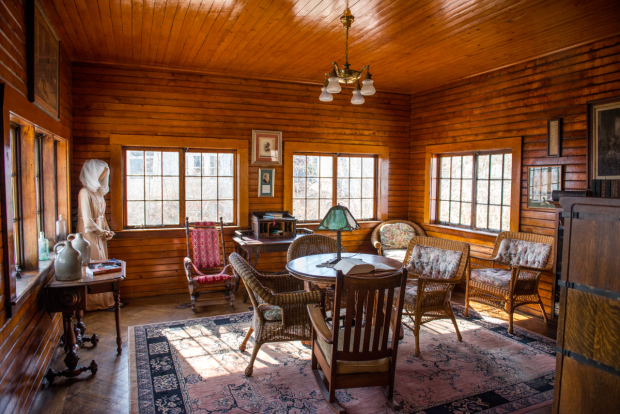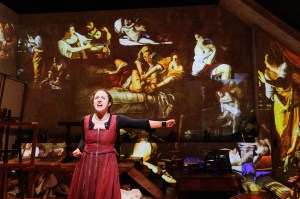Notes on O'Neill's Ghosts (Part II)
”Long Day’s Journey Into Night” haunts America for so many reasons.
This is part II of Michael Feingold's latest "Thinking About Theater" column. Click here to read part I.

(© Isaak Berliner/O'Neill Center)
Climate change has greatly diminished the thick morning fogs that used to roll in from Long Island Sound, covering the Connecticut shoreline around New London with a blanket of woolly gray. In the two decades or so that I spent working at the O'Neill Center, as a dramaturg for the National Playwrights Conference and teaching in the National Critics' Institute, we used to call them "Mary Tyrone mornings." By midday the fog had usually burned off, but would often roll in again toward evening. We O'Neillites knew from experience exactly why the fog gets Mary Tyrone so depressed, and how frightening it can get at its thickest. I remember taking a late-afternoon stroll along Waterford Beach, which adjoins the Center, with two visiting friends. As we walked, chattering about theater, a high-density fog rolled in behind us. When we turned to go back, we found ourselves walking in near-total darkness calling out to one another, and sometimes joining hands, to stay together as we stumbled along our way.
The Center itself has a haunted past that links to O'Neill's own. Its site, in Waterford, just outside New London, was once the estate of the railroad tycoon Edward Crowninshield Hammond, who, with his near neighbor, the Standard Oil millionaire Edward S. Harkness, possessed this prime stretch of Connecticut shoreline. They frequently had to chase trespassers — including the young Eugene — from its attractive beach. When you walk on the beach at night, the lights of the nearby Ocean Beach amusement park twinkle in the distance — just as they do when Richard Miller meets his Muriel in O'Neill's Ah, Wilderness!
O'Neill channeled his resentment of the beach-owning plutocrats into his late plays, merging Hammond and Harkness in a character called Harker in Long Day's Journey Into Night and T. Stedman Harder in A Moon for the Misbegotten — an officious millionaire constantly outmaneuvered by his Irish tenant farmer: A local anecdote about Hammond's running battle with his tenant, Dolan, supplied the story, in both plays, of the pigs in the ice pond. (The farmhouse where the Playwrights Conference tech staff resides was alleged to be Dolan's residence — Moon for the Misbegotten's setting.)

The town of Waterford acquired the Hammond property in 1964. (The Harkness estate is now Harkness Memorial State Park.) They initially planned to tear down the Hammond family mansion, Ironsides, as a fire-department exercise, but George C. White, a passionate theater man whose family were longtime area residents, managed to rescue it by creating the O'Neill Center. Its early years, as the Playwrights Conference and other O'Neill Center activities began to evolve, were chancy. I've often heard White reminisce about his shock when, while soliciting contributions among the local gentry, he found that some of their elders still retained hostile memories of O'Neill as a girl-chasing, troublemaking youngster from a disreputable family.
Inside the Hammond mansion, where most Conference participants stayed in the early years, there were even otherworldly manifestations of disapproval. At least two ghosts were rumored to stalk its corridors, one of them the spirit of old Mrs. Hammond, who had been a leader in the social ostracism of Ella O'Neill, and whose postmortem reaction to finding her earthly domicile occupied by a crowd of raffish theater people was emphatically negative. Many eerie occurrences were reported. After one experience, the costume designer Fred Voelpel frankly refused to sleep in the mansion again. Playwrights were warned not to doze off in the third-floor library, a comfortable retreat that had quickly become their workroom and hangout; some who did do so reported being awakened by a hard shove, or a sudden chill, to find a disembodied pair of red eyes glaring at them.
When the O'Neill Center acquired Monte Cristo Cottage in the early 1970s, more emanations were reported, including the "cold spots" associated with ghosts. Even I felt the temperature drop the first time I walked into the second-floor storage room (called a "box room" in the 1910s) where the men, in Long Day's Journey hear Mary fumbling about. The acquisition of the house confirmed how deeply the place had sunk into O'Neill's memories: some pieces of furniture found there, including the two small glass-fronted bookcases, were exactly as described in Long Day's Journey's stage directions.

(© Isaak Berliner/O’Neill Center)
The manifestations at both the mansion and the cottage have faded with time. The busy, bustling O'Neill Center of today seems unhaunted as well as largely fog-free. But Long Day's Journey, so steeped in the life of the place as it burned itself into O'Neill's youthful memory, never stops haunting us, just as it never stopped haunting its author. In 1924, when O'Neill at the height of his first fame — already a double Pulitzer Prize winner — tackled the daring subject of interracial marriage in All God's Chillun Got Wings, he named the tormented mixed-race couple at the center of the work Jim and Ella: his parents' names. The great critic Stark Young once said that in even the worst of O'Neill's plays, he was moved by "the cost to the dramatist of what he handled." That may be the most useful critical rubric ever formulated about O'Neill. We feel what his plays cost him. When he achieves universality, as in Long Day's Journey, we bear the cost with him.
O'Neill does not knock The Count of Monte Cristo, though its hokum would have made an easy target. Instead, he lets James punish himself, in the giant fourth-act lament about how "that god-damned play" took over his life. The real James O'Neill may well have done so. For theater artists, especially writers, this speech rings with exceptional pain. For O'Neill, it was not merely a personal matter: This is the most heartfelt of the many moments when Long Day's Journey opens out onto an enormous social vista. What Tyrone condemns in himself, O'Neill condemned in America. Written in 1941, Long Day's Journey was safely locked in a vault, with instructions that it not be played till 25 years after O'Neill's death, when, in 1946, he provoked a small thunderstorm in Henry Luce's office at Time magazine.
Time was preparing a cover story on O'Neill, to honor the arrival on Broadway of The Iceman Cometh, his first new play to be produced in 12 years. But the playwright told an interviewer that, in his view, America, "instead of the most successful country in the world," was in fact "the greatest failure," because, "its main idea is that everlasting game of trying to possess your own soul by the possession of something outside of it." Materialism was America's besetting sin. Luce, a staunch Republican and capitalist, took umbrage. Thus arrived the only occasion in Time's history when its publisher used his weekly letter to the readers to denounce the hero of that week's cover story. Time panned The Iceman Cometh too, as did many in 1946. New York didn't begin to comprehend the play's greatness till 10 years later, when José Quintero's off-Broadway production, starring Jason Robards Jr., opened at Circle in the Square in the spring of 1956.
Seeing that production was in part what compelled Carlotta Monterey, O'Neill's widow, to break his ban on performances. She offered Long Day's Journey to Quintero, who staged it on Broadway that November, with Fredric March and Florence Eldridge as James and Mary, and Robards as Jamie. That began the long parade of productions which have enabled Long Day's Journey to grow inside us, like a second skin. However far our own families are from the Tyrones' hellish torments, however different our own struggles might be from theirs, these people are a part of us. We cannot help loving them as they love each other, "in spite of everything."
Michael Feingold's next two-part "Thinking About Theater" column will appear on consecutive Fridays September 9 and 16.
Michael Feingold has twice won the George Jean Nathan Award for Dramatic Criticism, most recently in 2015 for his "Thinking About Theater" columns on TheaterMania, and has twice been a finalist for the Pulitzer Prize in Criticism. He serves as chairman of the Obie Awards and has also worked as a playwright, translator, and dramaturg.










